Jaipur Farmer Uses Natural Methods To Grow Cucumbers Worth Rs. 30 Lakh Per Year
Ganga Ram grows the cucumbers in his polyhouse using the soil solarisation technique.
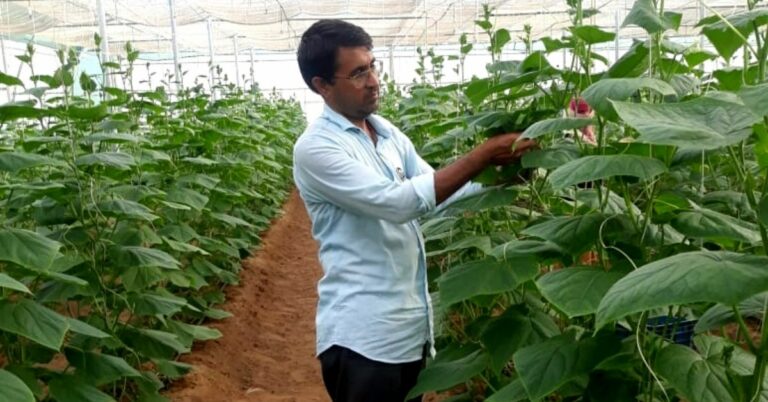
Jaipur-based farmer Ganga Ram Sepat had always grown crops like wheat, bajra, maize, and jowar, in his family’s six-acre land. Things changed in 2013 when he read about how pesticides and chemicals had given rise to cancer cases in rural Punjab.
“I knew that there was an urgent need to change my ways. It affects the quality of the soil, the production and the health of the grower. We decided to completely do away with fungicides and insecticides immediately,” says the 43-year-old farmer who hails from Kalakh village in Rajasthan.
With a deep interest in farming, he quickly transitioned to an organic way of growing food. In 2016, the avid farmer chanced upon a new way of growing food — polyhouse (or polytunnel).
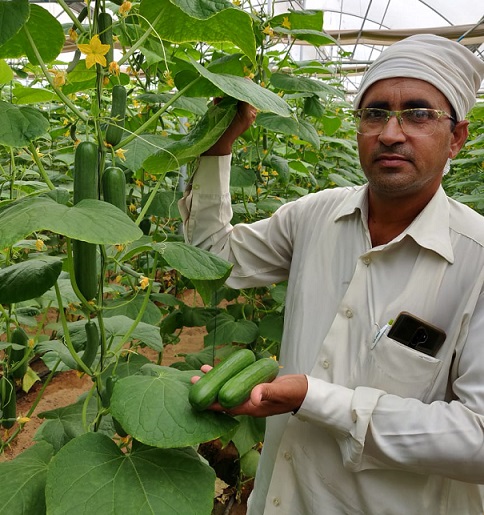
He also enrolled in a course to learn how to farm in a polyhouse. And now, in a three-acre polyhouse, Ganga Ram is growing cucumbers and earns Rs 30 Lakh in a year.
Additionally, in his six-acre family-owned farmland, he is organically growing strawberries, broccoli, sweet corn, tomatoes, chili, iceberg lettuce, wheat, okra, and wheat, among others.
In conversation with The Better India (TBI), Ganga Ram shares the unique farming techniques that have turned his business profitable and ensured that his farm yields toxin-free food for the consumers.
Passion for Agriculture
Ganga Ram was always interested in agriculture, so when it came to picking subjects in the Government Shakambhar college at Sambhar lake, he opted for Botany, Zoology and Chemistry and graduated in 1998.
In 1999, he decided to open a school in his village where he serves as the Director. “I wanted to open a school because there were issues of unemployment and I wanted the children in my village to have access to a good education that would help them get more opportunities in the future,” he says.

But over the years, his engagements in the affairs of the school were minimized as he got more and more involved in agricultural practices. While visiting his friend in the neighbouring village, Ganga Ram heard of Khema Ram, a farmer growing food in a polyhouse. Intrigued, he visited Khema’s farm.
“My family had always been very well-known in our area for the farming practices that we had adopted. The agricultural universities in the area too recognised our farming efforts but I noticed that we weren’t really adopting any modern farming techniques. This was really holding us back,” he shares.
Ganga Ram quickly visited the International Horticulture Innovation And Training Center (IHITC) in Jaipur to learn more about setting up a polyhouse and also learned techniques of preparing the soil, called ‘soil solarisation’. After finishing the three-day training, he started putting his knowledge to practice.
After receiving his training in IHITC, he finally set up his first polyhouse in October 2017.
Learning the Ropes of Polyhouse Farming
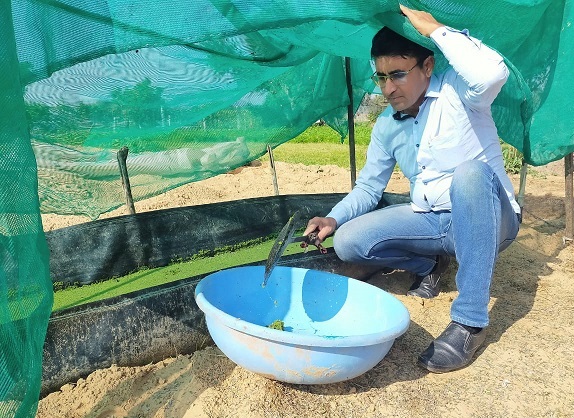
The most important method is the soil solarisation inside the polyhouse. This method makes use of solar power to kill and weaken pathogens in the soil making the technique environment friendly.
The steps involved in Polyhouse Farming are as follows:
* Mix manure (cow dung, vermicompost, seaweed granules, neem cake) with the soil.
*Moisten the soil using sprinklers.
*Set up a drip irrigation system.
*Cover the soil with a 25-micron thick poly sheet.
*Keep the soil wet and warm for 15 days.
*The temperature outside should be about 40 degrees celsius so that the poly sheet-covered soil absorbs all the heat.
*“If the temperature is not 40 degrees celsius on all days, follow this method for a few more days to make up for it,” says Ganga Ram.
*Remove the poly sheet and turn the soil again.
*Install the drip lines adjacent to the beds.
*Source a mulching sheet which is black in color on one side and silver on the other. If temperatures are too high, Ganga Ram advises to remove the mulching sheet especially in the summer months as it may heat up the soil a little too much.
*Cover the beds again with this sheet (with the silver side facing up)
*The whole objective of laying the sheet is to reflect the heat as too much heat is not needed at this point.
*Punch holes (with a diameter of two to three inches) into the sheet and through these holes, carefully sow the seeds half an inch in the beds.
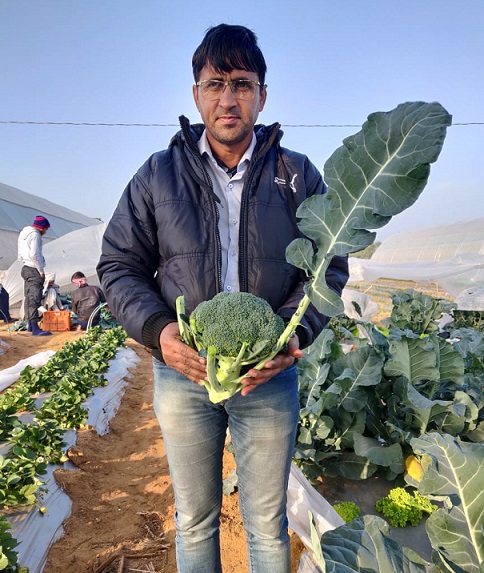
“Ensure that each of the holes you make on the sheet is large enough to accommodate the growth of the cucumber plant. Moreover, plant each seed at a distance of about 1.5 to 2 feet so that they not only get enough space to grow but also that they do not have to fight for resources like air, water and nutrition,” adds Ganga Ram.
In about 35 to 40 days, your first harvest will be ready. Ganga Ram plants almost over 7,500 seeds in the polyhouse and since the crop cycle is short, he can grow them, again and again, using the same materials (reuse the same mulching sheet and the poly sheet).
Tackling the Challenge of Pest Control, Helping Others
Ganga Ram mentions that the biggest benefit of soil solarisation is that it reduces the chances of fungal disease, weeds and nematodes (microscopic species) that attack plants.
“This is one of the biggest concerns for polyhouse growers and once these nematodes attack the roots, they make a colony for themselves. This strips the ability of the plant to take up nutrition,” he cautions.

To tackle this problem, in addition to using organic manures (like jeevamrutha) that keep the soil healthy, he uses something he calls ‘Sampurna Jaivik Kadha’, (neem oil and natural bio-cultures) he sources from the National Research Centre on Seed Spices in Ajmer.
He explains that the Sampurna Jaivik Kadha is a mix of jeevamrutha (made using cow dung, cow urine, jaggery, besan and soil), dried leaves, aloe vera, tobacco, garlic, neem leaves, Datura Alba leaves (toxic against aphids).
The bio-cultures too comprise a good variety of bacteria and fungi that help in managing attack on crops. Ganga Ram mentions that he uses about 15 litres of bio-culture on one-acre land (diluting it with water in the ratio of 1:9) and sprays it through the drip irrigation system.
Seeing Ganga Ram’s unique techniques of growing these cucumbers, quite a few farmers have taken inspiration from him and Ganga Ram has gladly helped them out.
One such farmer is Babulal Mahariya who was growing bajra and wheat two years back using inorganic methods. But, he decided to switch to natural methods because he felt that could do a world of good for consumer’s health. Now, he too is maintaining a one-acre polyhouse where he grows toxin-free cucumbers as well.
“He (Ganga Ram) gives me all the information and I write it in my notebook. Together, we sit and make a schedule. I’ve also learnt how to make jeevamrutha and use bio-cultures in my crop. We keep meeting from time to time. I even set up a WhatsApp group of farmers from the village. Here, we share the best practices and tips for growing our crops,” he says.
Challenges and Looking forward
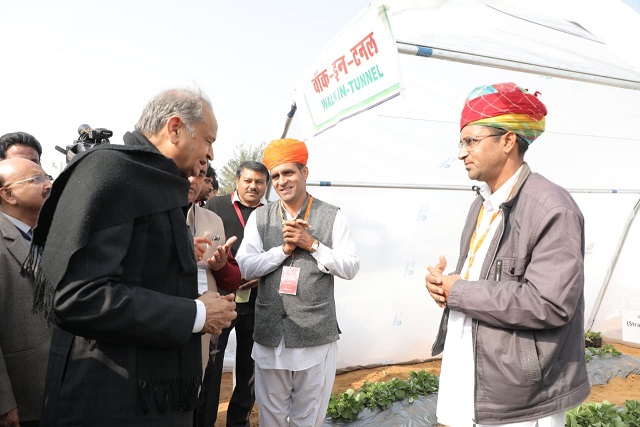
Despite these positives, Ganga Ram mentions that there are certainly a few challenges that he has come across over the years of trying to grow food naturally and free of toxins.
“The biggest challenge is that not a lot of people know about these modern techniques and this stops a lot of farmers from even starting out. Besides, although we are growing food naturally or using organic methods, there is no platform where we can sell our produce. We have to go to the same mandis to sell despite making that extra effort of not using chemicals,” he says.
He hopes that with the emergence of such platforms, farmers would get more pay and that would also urge them to employ best natural practices.
Ganga Ram mentions that he wants to grow mushrooms in the future. He also has a fish pond where he cultures fish like Rohu, and Katla. He has also heard a lot about hydroponics and wants to try his hand at that as well.
“Everyone looks down upon agriculture as a profession. I want to prove that any farmer can earn profitably by incorporating good practices. I want to urge all farmers to move away from chemicals so that they can grow food which keeps the soil healthy as well as the people who eat it,” he says signing off.
If you want to get in touch with Ganga Ram Sepat for queries, please contact him at +91 98877 82381
(Edited by Saiqua Sultan)
Like this story? Or have something to share?
Write to us: [email protected]
Connect with us on Facebook and Twitter.
If you found our stories insightful, informative, or even just enjoyable, we invite you to consider making a voluntary payment to support the work we do at The Better India. Your contribution helps us continue producing quality content that educates, inspires, and drives positive change.
Choose one of the payment options below for your contribution-
By paying for the stories you value, you directly contribute to sustaining our efforts focused on making a difference in the world. Together, let’s ensure that impactful stories continue to be told and shared, enriching lives and communities alike.
Thank you for your support. Here are some frequently asked questions you might find helpful to know why you are contributing?


This story made me
-
97
-
121
-
89
-
167













